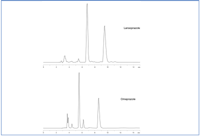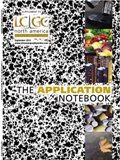Achieving Enantiomeric Separation of Anti-Ulcer Drugs Using Lux Cellulose-4
Polysaccharide-based chiral stationary phases (CSPs) are often utilized for a broad range of enantiomeric chromatographic separations due to their wide chiral recognition ability.
Scott Krepich and Christopher Fernandez, Phenomenex Inc.
Polysaccharide-based chiral stationary phases (CSPs) are often utilized for a broad range of enantiomeric chromatographic separations due to their wide chiral recognition ability. A new chiral column with unique selectivity, Lux Cellulose-4, was used to achieve good separation of anti-ulcer drugs under reversed phase conditions.
In many cases in pharmaceutical drug development, one of the two enantiomers of a specific compound is the active pharmaceutical ingredient (API) and the other enantomer is either inert or toxic. Researchers look to chiral chromatography to purify these enantiomers and often a unique chiral selectivity is required to separate specific classes of compounds. Lux Cellulose-4 is a new unique chiral stationary phase using a tris (4-chloro-3-methylphenylcarbamate) derivative of cellulose (Figure 1). Here, its chiral recognition abilities under reversed phase conditions were demonstrated for the anti-ulcer drugs; lansoprazole and omeprazole.

Figure 1: Chemical structure of the Lux Cellulose-4 polysaccharide-based chiral phase.
Materials and Methods
All chemicals were obtained from Sigma Chemicals (St. Louis, MO) and solvents were purchased from EMD (San Diego, CA). All compounds were analyzed on an Agilent 1100 HPLC with an autosampler, column oven, variable wavelength detector, and data was collected using Chemstation software. The column used for all separations was a Lux 5 µm Cellulose-4 250 x 4.6 mm (Phenomenex, Torrance, CA) and flow rate was 1 mL/min. Separations were monitored at 220 nm. Mobile phase composition was 20 mM ammonium bicarbonate/0.1% diethylamine with varying amounts of acetonitrile (70:30 for lansoprazole and 80:20 for omeprazole).
Results and Conclusions
While some trends are often seen between classes of compounds, chiral separations are usually very compound and phase specific with no set chromatographic rules for selectivity. Polysaccharide-based chiral stationary phases tend to have the most widespread applicability for a variety of compounds, but still different types of polysaccharide columns and mobile phase conditions must be screened to achieve maximal separation of enantiomers. For the anti-ulcer compounds, lansoprazole and omeprazole, the maximum resolution and best overall chromatography was achieved under reversed phase conditions on Lux Cellulose-4 (data not shown). After the initial screen of chiral stationary phases using generic conditions, mobile phase was optimized to increase resolution of the enantiomers. Chromatograms of the optimized conditions for the enantiomeric separation of each compound are show in Figure 2. In the case of lansoprazole, the optimal mobile phase condition was 70:30 acetonitrile: buffer, and for omeprazole 80:20 acetonitrile: buffer on the Lux Cellulose-4 column.

Figure 2: Separation of anti-ulcer enantiomers lansoprazole and omeprazole on the Lux 5µ Cellulose-4 chiral column. Note the good separation of the different enantiomers of each compound. Lux Cellulose-4 provides a unique selectivity for different chiral compounds.
These results show an example of the utility of the Lux Cellulose-4 media as a unique chiral selective phase for the separation of these anti-ulcer enantiomers.

Phenomenex Inc.
411 Madrid Ave, Torrance, CA 90501
tel. (310) 212-0555; fax (310) 212-7768
Website: www.phenomenex.com

SEC-MALS of Antibody Therapeutics—A Robust Method for In-Depth Sample Characterization
June 1st 2022Monoclonal antibodies (mAbs) are effective therapeutics for cancers, auto-immune diseases, viral infections, and other diseases. Recent developments in antibody therapeutics aim to add more specific binding regions (bi- and multi-specificity) to increase their effectiveness and/or to downsize the molecule to the specific binding regions (for example, scFv or Fab fragment) to achieve better penetration of the tissue. As the molecule gets more complex, the possible high and low molecular weight (H/LMW) impurities become more complex, too. In order to accurately analyze the various species, more advanced detection than ultraviolet (UV) is required to characterize a mAb sample.















